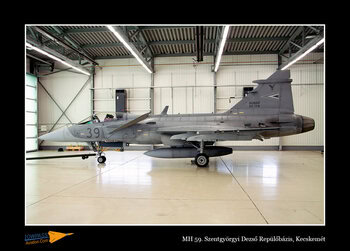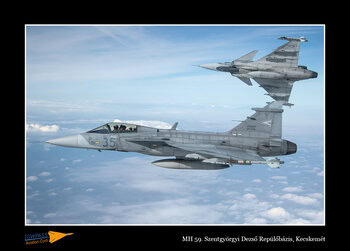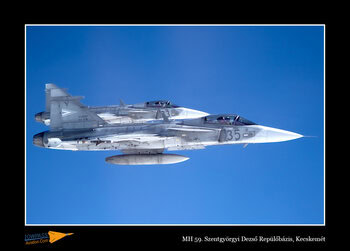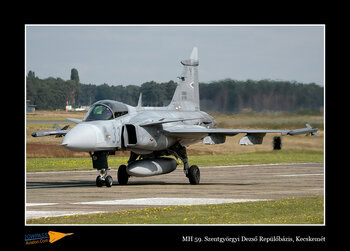MH 59. Szentgyörgyi Dezső Repülőbázis, Kecskemét
History:
Before the second world-war, Kecskemét was used by the Hungarian Air Force. During the war the Luftwaffe used it as a transit airfield. During 1941 and 1942 it main purpose was a transit airfield for aircraft en-route between Germany and the Balkans, mainly Romania. In 1943 the airfield was developed to a much larger airfield with a concrete runway. The runway measured approximately 1325 meters. A taxiway was under construction to the hangar area, and the airfield was equipped for night operations. In June 1944 39 P-38 Lightinings strafed the airfield, destroying 7 Me323s (US claim) or 2 Me323s (German claim). In August 1944 two more attacks were made by Allied aircraft, this time P-51 Mustangs, destroying 24 aircraft in the first attack and 150+ aircraft on the ground in the second attack at Kecskemét and Nagyvárad. Operational units stationed at Kecskemét during the war were 3. Hungarian Short-Range Reconnaisance Group (1941-1944) and several German units, both fighter and support units. All fighting in Hungary ended on 16 April 1945. After the war Kecskemét had to be rebuilt as is suffered major damage by allied attacks. The reconstruction lasted until 1948.
The presence of Soviet troops in Hungary was formalized by the 1949 mutual assistance treaty, which granted the Soviet Union rights to a continued military presence, assuring ultimate political control. The Soviet Forces in Hungary were part of the so-called Central Group of Forces headquartered in Baden near Vienna. From March 15th 1952 31 MiG-15 and 2 Yak-11s were stationed at the airbase for training purposes. In September the same year the Soviets ceased pilot training and all aircraft were transferred to the Hungarian Air Force 24. Fighter Air Regiment. From 1967 93. GvMSD was stationed at Kecskemét-Kadafalva with Mi-2, Mi-4, Mi-8TV, Mi-24D, Mi-24P and Mi-24K/RCh.
When the Soviet Union fell apart, Hungary declared itself independent. In the early 90s at Kecskemét 59. ‘Szentgyörgyi Dezsö Harcászati Repülö Ezred (59.HRE) was based with two squadrons Mig-21MF and UMs. During the 90’s a lot changed within the Hungarian Air Force and in 1993 they acquired 28 MiG-29 Fulcrums from Russia as part of the payment of Russian debts to Hungary. Those MiG-29s were based at Kecskemét and replaced the ageing MiG-21s. Also the An-26 Curl transport aircraft, which were based at Szolnok, transferred to Kecskemét.
Later on the Hungarian Air Force established an Air Academy at Szolnok Air Base. For this academy twelve Yak-52s were aquired from Romania, which were based at Szolnok, as well as twenty L-39ZOs from former East Germany which were based at Kecskemét Air Base. The L-39s belonged to 3. „Szárnyas Csikó Repülőszázad” (Pegasus squadron) and were retired from service in December 2009. After the retirement of the L-39s also the 3. „Szárnyas Csikó Repülőszázad” was disbanded. The MiG-29s belonged to 2. “Dongo” Vadászrepülö Század and made their last flight in December 2011. The An-26 Curl transport aircraft made their last flights in June 2020 after 45 years of service.
Present:
At this moment MH 59. Szentgyörgyi Dezső Repülőbázis, Kecskemét is based at Kecskemét and this Wing consists of three squadrons. The first is „Puma Harcászati Repülőszázad” (Tactical Fighter Squadron) which are flying the Jas39C and D Gripens. The second is „Dongó Harcászati Kiképző Repülőszázad” (Tactical Fighter Training Squadron), they are doing the initial tactical training for new Gripen pilots. The third squadron is Szallitó Repülö Század („Camel” Air Transport Squadron) and they are flying the A-319s and Falcon 7Xs.
In 2001 the Hungarian Air Force started the negotiations with the Swedish company SAAB for the leasing of twelve single-seat JAS39C and two dual-seat JAS39D Gripens to replace the ageing Russian made MiG-29 Fulcrums. The first delivery of the JAS39 Gripen was in 2006. The lease contract was for ten years and in 2016 the contract was extended for another ten years, until 2026.
At the end of 2016 the Hungarian Government launched the ambitious “Zrinyi 2026” modernisation programme and since then a lot has changed within the Hungarian Air Force. Two A319s and two Falcon 7Xs were bought. The A319s were delivered in the beginning of 2018. The first Falcon 7X was delivered in augustus 2018 followed by the second in april 2019.
1.Harcászati Repülőszázad:
The nickname of this squadron is “Puma” and at this moment they are flying with twelve single-seat (C) and two dual-seat (D) JAS39 Gripens. In total the squadron has 20 Gripen pilots. These pilots are flying about 100 hours a year in the aircraft itself and about 30 hours in the simulator. In the simulator emergencies and new phases of tactical training are being practiced.
Since 2013 the Squadron commander is Lieutenant Colonel Sandor Kallo. After high school he went to the Military school followed by the military academy from 1993 until 1997. After training at the L-39 Albatros he went in 2002 to Canada to the NFTC for phase 3 and 4 fighter training on the Hawk. After this he flew the MiG-29 fighter aircraft. With the arrival of the JAS39 fighter aircraft in 2006 he went to Sweden with the second group for retraining to the JAS39 Gripens in 2007. In total he flew 50 hours on the MiG-29 and about 1.000 hours on the JAS39 Gripen.
3.Szallitó Repülö Század
The nickname of this squadron is “Camel” and at this moment they are flying two A319s and two Falcon 7Xs. Within this squadron there are also two female pilots, one on the A319 and one on the Falcon 7X. The main tasks of this squadron are passenger transport and VIP flights. The Falcon 7X is used mainly for VIP flights and support flights, the larger A319 is used for troop transport and if necessary for support and VIP flights.
Lieutenant Lea Zolnai is the female pilot on the A319 and started her career at Szolnok with the pilot training. On the university she got the theoritical and physical training. From there 4 students went to the USA and she was the only one from Hungaria. First she went to San Antonio, Texas to learn English and after that she started the Aviation Leadership Program and flew for 1,5 year on the T-6 Texan and trained in the simulator at Columbus Air Base, Mississippi. This base is extremely busy with at least 300 flights a day. While being in the United States of America she got a call that the Hungarian Air Force was looking for pilots for the A319 and in September 2017 she went back for training to become an A319 pilot. This training was in Prague, Czechia and also included 50 hours in the simulator. After this she went back to Hungary for training on their own A319, this training included also 5 circuits and 5 landings. She passed this training in 2018 and got her pilot license. Every 6 months she has a emergency test in the simulator which she needs to pass. At this moment she has 600 flying hours on the A319 which makes it around 200 flying hours a year.
Major Akos Orosz is on of the pilots on the Falcon 7X. He was philologist and in September 2007 he joined the Hungarian Air Force. In March 2008 he started flying on the YAK-52 aricraft at Szolnok Air Base and two months later, in May 2008, he went to the NFTC based at Moose Jaw, Canada. In October 2009 he finished his training on the CT-156 Harvard and transferred tot he Hungarian Air Transport Squadron at Kecskemét Air Base. In 2010 he finished the practical training for the An-26 Curl transport aircraft and in 2017he became Pilot on Command. It was known to the pilots that the Hungarian Air Force was buying A319s but it was unknown wat the second aircraft should be. He was designated to this so called “little bird”. When the news came out that the Hungarian Air Force bought the Falcon 7X he went to Burgess Hill, United Kingdom for 40 hours training on the simulator and two weeks of ground school. At this moment he already made 750 flying hours on the Falcon 7X. The squadron has 11 pilots for the Falcon 7X. The longest non stop flights he has made with the Falcon 7X was from Budapest to Tampa, United States of America, flight time 12 hours and 30 minutes. The crew of the Falcon 7X consists of 4 persons, pilot, co-pilot, onboard technician and flight attendent. He flew from 2009 till 2018 on the An-26 and then switched to the Falcon 7X which is a very silent aircraft compared to the An-26 which makes noise over 100 decibel.
Training:
After the basic military training, which lasts two years, the basic flying training starts at the Zlin 143 and Zlin 242 training aircraft. When the student is capable enough they will go to Canada to the NFTC where they will start flying in the Harvard II and after passing this they will fly the Hawk. The following step in their education is to fly the JAS39 Gripen and this training is in Satenas, Sweden. There they will learn the basic aircraft handling. When they will pass this training they go back to Hungary to resume their operational training. During this training they will learn how to fly low level and give Close Air Support (CAS) and get their Quick Reaction Alert (QRA) qualification. This training also lasts around one year. During this whole training the pilots are checked many times if they are fit enough and also if their medical status is capable enough to fly fighter aircraft.
For training at Kecskmét there is only one simulator. If the Gripens are upgraded then first the simulator will be upgraded before the aircraft will receive this upgrade. For the tactical training the pilots go to Sweden because there are eight connected simulators available and that’s much easier for training tactical scenario’s. The Hungarian pilots also train in Sweden with live ammunition for the guns and missiles during live firing exercises.
Maintenance:
The JAS39 Gripen aircraft are getting overhauled every 50 and 200 hours. This maintenance is done at Kecskemét Air Base. The larger maintenance which is done every 800 hours is done by SAAB in Sweden. Also the technicians receive their training in Sweden. The smaller maintenance on the A319s and Falcon 7Xs are done at Kecskemét. The two Falcon 7x are send to the Dassault Maintenance Center located in Le Bourget, France every 12 months, here they receive the necesary aircraft inspections and the major maintenance phase. Large maintenance on the A319 (called C check) is done by Aeroplex Ltd. in Budapest.
Quick Reaction Alert (QRA):
The Hungarian Air Force has 365 days a year 24/7 JAS39 Gripens on QRA stand-by. This QRA stand-by is not only for Hungary itself but also for Slovenia and periodically the Baltic States (Estonia, Latvia and Lithuania). When an airplane has communication problems or there is no flightplan filed than the QRA is scrambled to intercept the airplane and communicate with the pilot of the aircraft to see if everything is allright. If not they force the plane to land. In 2022 the Hungarian Air Force will send four JAS39 Gripens to Siauliai, Lithuania for Air Policing tasks above the Baltic states. This deployment will last four months. In 2019 the Hungarian Air Force already went to the Baltic States for Air Policing tasks and were scrambled many times and got up close with Russian fighters, transport and VIP flights like Su-24, Su-27, Su-30, Il-38, Il-22 and Tu-160s. The QRA in the Baltic States is similar to the one in Hungary. In the Baltic States the pilots wear dry suits. In case of an emergency and the pilot is in the cold water these dry suits makes it possible for the pilots to be in the cold water for 2 hours.
Future:
Under the “Zrinyi 2026” modernisation programme also two Embraer multi-mission KC-390s with air-to-air refuelling (AAR) capability were bought in November 2020. Those aircraft should be delivered to the “Camel” squadron in 2023. Another part of this modernisation program is to buy training aircraft and the candidates are the Aero L-39NG and Embraer Super Tucano. There is need of more transport and VIP aircraft but it is currently unclear whether the Hungarian Air Force will invest in this.
The Jas39 Gripens are leased till 2026 and recently the Hungarian Air Force has chosen to update the JAS39s instead of leasing new-build JAS39E Next Generation Gripens. The Gripens will be upgraded to the newest MS20 Block 2 standard. It is expected that the lease contract will be extended for an unknown number of years.
The MS20 Block 2 upgrade significantly improves the aircraft’s combat and communication capabilities by boosting Link 16(NATO Data Link) functionality and updating voice communication to the most recent NATO secure communication standard. It also offers a wide variety of weapons that can be installed on the aircraft, including GBU-49 modern air-to-ground laser-guided bombs, IRIS-T infrared Within Visual Range (WVR) air-to-air missile and Meteor long-range radar-guided BVRAAM that outperforms other missiles. The radar will be updated to the PS-05/A Mk 4 that improves sensor capability, extending the air-to-air target tracking range and improving performance and the latest Identification Friend of Foe (IFF) NATO Mode 5 will also improve the capacity to recognise coalition aircraft.
Demo pilot Lieutenant Maté Majerik:
The Hungarian Air Force has two pilots who fly their demonstrations with the JAS39 Gripen. Both are operational pilots and this is an extra task for them. The Squadron commander, Operations commander and the Base commander ask the pilots who would like to be the demo pilot and then they choose who will be the demo pilots for the next few years. Because there are only 20 pilots within the squadron the demo pilots will not be changed often. To be a demo pilot you must have at least 500 hours on a jet from which 350 hours have been made at the JAS39 Gripen.
Lt. Maté Majerik applied to the Hungarian Air Force to become a fighter pilot in 2009. He went to Szolnok to learn the basic stuff, aerobatics, navigation, IFR flying and formation flying on the Yak-52. After three months he went to the NATO Flying Training Canada (NFTC) based at Moose Jaw for two years. For him the first six months were very intense because he needed to learn all the procedures. Phase 1 of his training was in Hungary on the Yak-52. Phase 2A was in Canada on the Harvard to see if he was capable enough to become a fighter pilot. If he did not pass this phase then he could go further to become a helicopter pilot but he passed and continued to phase 2B which was still on the Harvard. After this phase 3 followed and that was flying the Hawk Mk.15. During this phase he made 60 flying hours to train IFR and VFR flying as well as formation flying. Also this phase included training on the simulator. Phase 4 was the last part of the training and was also on the Hawk. This phase contained tactical training, air-to-air, 2 versus 1, air intercept, air to ground, close air support, low level flying as well as training to fire the gun and dropping bombs. When phase 4 is completed than you’re capable to become a fighter pilot. The next step was to go to Sweden to make about 100 flying hours on the JAS39 Gripen and after that he was ready for the Hungarian Air Force.
For him the reason to fly the demo is because it’s more flying to the edge which needs more training. For example flying a role is not in the operational training. He started his demo to think about which manouvres needs to be in the demonstration. Then he went to the simulator to train the basic aerobatics at a 3.000 feet bottom like the 4-point roll, slow roll and fly inverted. He kept on training this manouvres and lowered the bottom to 1.000 feet. Then he put the aerobatics behind each other to put sequence in the program. When for him the demonstration was as it should be, the demonstration still had to be approved. After approval the demonstration could be trained in a real aircraft. The pilot needs to be comfortable with the demo he is flying and also has to have his own style, that’s why every country or pilot is flying a different demonstration on the same aircraft. He has been demo pilot since 2019 and is not thinking of stopping with it!
The authors of Lowpass Aviation.com would like to thank the personnel of the Hungarian Air Force for their hospitality and help during our visit at Kecskemét Air Base!























